QUESTIONS
SECTION A (20 marks)
Answer all the questions in this section in the spaces provided.
-
- Identify the colours labelled X and Y.(2 marks)
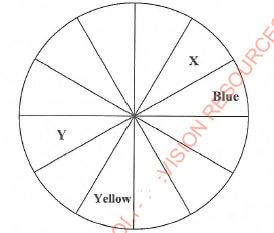
- Contrast between symmetrical and asymmetrical balance. (2 marks)
- Explain the importance of still life drawing. (2 marks)
- State the significance of firing clay articles when bone dry (2 marks)
- Define tromp l'oeil art technique. (2 marks)
- Outline two components of montage. (2 marks)
- Sketch the motif below as it would appear on a block for printing. (2 marks)
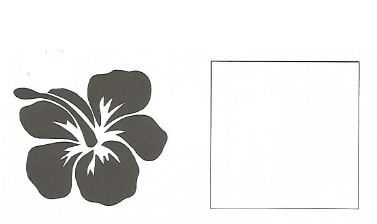
- Identify the type of symbol below and state its use.(2 marks)
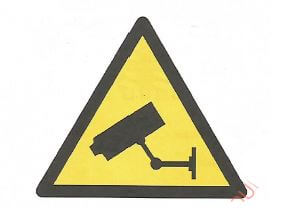
- Outline two ways in which balance has been achieved in the sculpture.(2 marks)
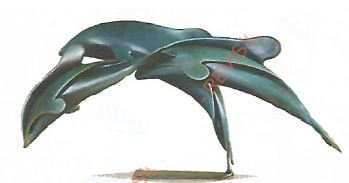
- Identify the colours labelled X and Y.(2 marks)
SECTION B (25 marks)
Answer all the questions in this section in the spaces provided.
-
- Compare the contrast effects of different colour backgrounds for the red square.(2 marks)

- Discuss three major contributions of colour in painting. (3 marks)
- Compare the contrast effects of different colour backgrounds for the red square.(2 marks)
-
- Explain a warp-faced plain weave.(2 marks)
- The illustration below represents a technique in process:

- Identify the technique. (1 mark)
- Outline the process. (2 marks)
- Study the package designs and answer the questions below.
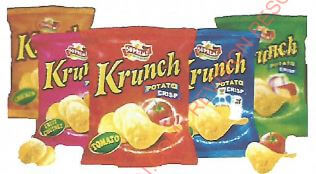
- State two packaging functions. (2 marks)
- Analyse the package designs with reference to:
- Colour(1 mark)
- Layout(1 mark)
- Lettering(1 mark)
- Describe two main methods of wedging clay.(5 marks)
- State five steps of fixing organdie onto a wooden frame in preparation for screen printing.(5 marks)
SECTION C (15 marks)
Answer any one question in this section in the spaces provided after question 9.
-
- Define each of the following terms with reference to pottery:
- Engobe(1 mark)
- Kidney(1 mark)
- Vitrification(1 mark)
- Discuss the steps of making a teapot using slip mould.(12 marks)
- Define each of the following terms with reference to pottery:
-
- Outline three basic elements of poster design(3 marks)
- Describe the process of designing and producing a poster.(12 marks)
- Explain the process of printing using a stencil and a silk screen on fabric.(15 marks)
MARKING SCHEME
-
- Identity of colours labelled;
- X is Blue-violet/purple;
- Indigo Y is Orange
2x1 = 2 marks
- Contrast between symmetrical and asymmetrical balance.
Any 2 x 1 = 2 marksSymmetrical balance Asymmetrical balance 1.Formal balance - regular and orderly in arrangement 1. Informal balance - Not regular 2.Passive forms - similar creates monotony in a composition 2.Active forms - creates varied interest in the composition 3.One side of the design is a replica of the other 3. Parts of one side of the line of symmetry contrast with those of the other but still appear to be in harmony with each other. 4.Static-creates a feeling of stability and uniformity 4. Rhythmic impressions - shows movement and variety in the composition. - The importance of still life drawing:
It enables one to- develop the ability to observe forms and surface qualities,
- develop skills in drawing,
- improve the ability to convey the play of light and dark on objects.
Any 2 x1 = 2 marks
- Significance of firing clay items when bone dry;
All the moisture is gone from the clay at this stage, which may cause the clay items to explode during firing.
2x1 = 2 marks - Distinction between a sketch and a study in art.
Any 2 x1 = 2 marksSketch Study 1. A rapidly executed freehand drawing that is not intended as a finished work, often consisting of a multitude of overlapping lines. 1. A rigorous analysis of the subject; looked at minutely 2. less detailed 2. Highly detailed rendition 3. Gesture of the subject; a brief basic drawing. 3. An artwork made in order to practise or demonstrate a subject or technique. 4. Quickly executed hence takes a shorter time 4. Takes time to bring out the details - Definition of tromp l'oeil art technique;
- Trompe l'oeil refers to the technique of visual illusion, whereby the eye of the viewer is deceived into thinking that a painting is actually a three-dimensional object, rather than a two-dimensional representation of it.
- It creates optical illusions (fools the eye /deceive) so the painted objects appear in three dimensions.
2x1 = 2 marks
- Two components of montage.
- Composed of pictures cut out of magazines, newspaper clippings, etc.
- Different pictures or parts of pictures are arranged by superimposing one on another, so that they form a blended whole while remaining distinct to create a pictorial composition.
Any 2 x 1 = 2 marks - Motif as it would appear on a block for printing;
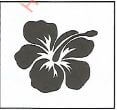
Correct placement (in reverse) 2 x 1-2 marks
- Type of symbol - Warning sign;1x1 - Imark
Use of symbol: warn (trespassers) that a premise is under surveillance, CCTV in operation.
1x1 = 1 mark
Total = 2 marks - Two ways in which balance has been achieved in the sculpture;
- physical balance; achieved by stable base,
- Visual balance; the jerking torso of the whales, creates an opposing force with the raised tails resulting in asymmetrical balance. 2x1=2 marks
- Identity of colours labelled;
-
- Contrast effects of different colour backgrounds for the red square;
- Red appears more brilliant against a black background and duller against the white background.
- In contrast with orange, the red appears lifeless; it exhibits brilliance in black; the red square appears larger on black than on other background colours.
Any relevant explanation x 2 - 2 marks
- Three major contributions of colour in painting;
- Spatial quality, colour provides spatial quality to the pictorial by varying values, thus creating depth,
- Mood and emotions; colour creates mood and expresses personal emotions, e.g. use of soft sombre colours creates an atmosphere of peace, tranquillity;
whereas use of bright colours suggest festive mood. - Symbolism; colour symbolizes ideas through traditional associations e.g. blue is associated with loyalty, red with blood, green with fertility, etc.
- Focus of attention; colour attracts and directs attention of the viewer to the desired focal point by use of outstanding, contrast colours thus emphasizing a specific area in the artwork
- Aesthetic value; colour can create an overall aesthetic appeal. This is done by use of colours in a well ordered, systematic way, at the same time harmonizing.
Any 3 explanations x 1 = 3 marks
Total = 5 marks
- Contrast effects of different colour backgrounds for the red square;
-
- Warp-faced plain weave;
- This is a weave where the warps are closely packed together and greater in number than wefts making the weft invisible except at the selvedge.
2 x 1 = 2 marks
- This is a weave where the warps are closely packed together and greater in number than wefts making the weft invisible except at the selvedge.
-
- The technique in process is twining/ twine weaving
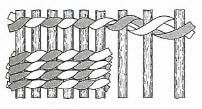
1x1=1 mark - Outline of the process;
- There are 9 warp strands, 2 weft threads crisscrossing each of the stiff warp strands making a twine The last 4 rows have been beaten down hence compacted
2 x 1 = 2 marks
3 marks
Total = 5 marks
- There are 9 warp strands, 2 weft threads crisscrossing each of the stiff warp strands making a twine The last 4 rows have been beaten down hence compacted
- The technique in process is twining/ twine weaving
- Warp-faced plain weave;
-
- Two packaging functions:
- containing and holding the product,
- protecting the product from damage,
- informing the customer about the product,
- creating brand identity to promote and help sell the product,
- making it convenient to carry, use and store the product.
Any 2 x 1 = 2 marks
- Package design analysis with reference to:
- colour
- eye-catching and bold colours,
- contrasting colours divide the image,
- colour is used to frame the lettering and the face, .
- all lettering is the same colour,
- use of warm and cold colours,
- the yellow shapes in the middle are bright and placed in the centre of the design for impact,
- contrasting use of flat colour and tone,
Any other well justified comment regarding colour
1 x 1= 1 mark
- layout
- Vertical format
- The lettering and illustration take a diagonal format
1 x 1 = 1 mark
- lettering
- design of the lettering/font with bold outline,
- simplicity of the fonts
- placement of the lettering
- readability of the lettering,
- flowing shapes of letters and words
- lettering fits into spaces within the overall design
- lettering is part of the image of the crisp
- variation in scale
Any other well justified comment regarding lettering 1 x 1 = 1 mark
3 marks
Total = 5 marks
- colour
- Two packaging functions:
- Two main methods of wedging clay:
- Ram's head; pushing the clay down and out releases trapped air, eliminates lumps, and makes the clay homogeneous. The clay resembles a ram's head after each motion.
- Spiral using a slight twist of the hands opens up all parts of the clay ball, allowing any air bubbles to escape. Spiral wedging also lines up the clay particles.
Naming mark each 1/2 x 2 = 1 mark
Explanation 2 marks each x 2 = 4 marks
Total = 5 marks
- Five steps of fixing organdie onto a wooden frame in preparation for screen printing.
- Lay the mesh on the frame and trim it all round to 5 cm more than the frame itself. Fold the excess mesh back and fix it along the top with a thumbtacks or staples.
- Use one staple every 5 cm, pulling the mesh downwards as tightly as possible, then staple the sides to the frame.I keep the mesh/gauze tensioned so that it fits without creases and the mesh/gauze pattern is parallel with the frame.
- Start tacking in middle of one of the long sides, working outwards fixing pins/tacks/staples
- Ensure the mesh is stretched on the rounded edge of the frame to avoid tearing, repeat on opposite side ensuring it is stretched as tightly as possible, test for tautness.m
- Cover the pins/tacks/staples with masking tape, mask around the screen.
Any five steps sequentially stated 5 x 1-5 marks
-
- Definition of terms with reference to pottery;
- Engobe; a white or coloured clay slip coating applied to a ceramic body to give it decorative colour or improved texture. A clay slip which is coloured with metal oxides or stains, used for coating the surface of a pot either before or after bisque firing.
- Kidney; derives name from its shape - kidney-shaped tool made of flexible steel for finishing thrown pots, or made of stiff rubber for pressing and smoothing clay in a mould./ A finishing tool used for the moulding, scraping, cleaning and smoothing of wet clay
- Vitrification; process by which clay materials bond/ fuse to become dense and non-absorbent as a result of firing/ convert clay into glass or a glassy substance by heat and fusion
3 x 1 = 3 marks
- Steps of making a teapot using slip mould;
- Prepare clay1m(slip); a mixture of fresh and recycled clay is mixed with water to create a liquid called slip. Stir clay and water using a blunger or a wooden stick,
- Open up the mould & brush out with a soft brush so that they are clean.m
- Put the pieces of the mould back together [most mould have 'keys' or notches to make sure they are aligned properly] by fastening the pieces firmly together using either bands or strap.
- Stand the mould on a flat surface with the 'spare' upwards 1m(The spare is the hole where slip is poured into the mould.)
- Pour slip into mould 1m; Pour slip slowly & evenly into the mould through the spare. Fill the mould right up to the top of the spare & leave it for a few minutes. Once the slip level has dropped - top it back up.
- Let it stand/settle1m until required thickness is achieved before it can be tipped,
- Drain the mould1m- slowly & gradually turn the mould over so that the spare is on the bottom , drain out excess slip from the mould, leaving a soft but solid layer of clay around the outside.
- Leave the mould with the cast inside until the cast is hard enough to support itself but not so hard that it's cracking1m Water is absorbed by the mould, leaving behind the basic shape of the teapot] The teapot is then left, so that it can continue to dry,
- Trim off the excess 1mclay from the mould which will not form part of the teapot.
- Carefully open the mould1m, ensure each piece is lifled straight off & not at an angle for this may destroy details. Remove the mould gently apart, then carefully remove the cast & leave it to dry until it's leather hard,
- Trimming/fettling (base of teapot)1m using a scalpel gently scrape away the seams/lines left by the mould, trim the base of the pot; sponge over these areas to ensure they are smooth and no traces of the seams are left.
- Leave the teapot to totally dry1m to a rigid solid, fettle and sponge again.
(Fettling, is the process of removing the mould lines left over from the casting process) round the square edges and open up the spout; using a knife/scalpel, - Decorate and fire 1m
Steps in sequence as highlighted = 12 marks
Total = 15 marks
- Definition of terms with reference to pottery;
-
- Three basic elements of poster design;
- Size/pictorial image/imagery
- Lettering/text titles
- Colour
3 x 1 = 3 marks
- Process of designing and producing a poster
STEP 1: Choose the size and format/orientation i.e. landscape or portrait after working out the content and defining the audience/aim of poster.
STEP 2: work on the content/ message choose content focus and outline the content in terms of: title, subheadings, captions, etc. for effective presentation.
STEP 3: Decide on the items on the poster;- Written information (words, instructions and/or explanations)
- Pictures/pictorial images, drawings or illustrations
- Letters (size and font), colour scheme, borders and shading
STEP 4: Decide on item placement/ layout of the poster, make thumbnail, rough and finally comprehensive layout sketches indicating the placement of the title, pictorial image, type of colours and fonts.
STEP 5: Prepare a draft of the poster marking using oblongs where pictorial images, text and narrative will fall.
STEP 6: Review the draft ideas and graphics for feedback on any information conveyed that isn't clear; proofread carefully and submit the final copy for printing,
Process as highlighted in sequence x 2 = 12 marks
Total = 15 marks
- Three basic elements of poster design;
- The process of printing using a stencil and a silk screen
- Design print
- Transfer image by tracing it onto paper stencil or clear film or sticker
- Cut out image with a stanley knife/ cutter/craft knife,
- Mount image in reverse onto centre back of the screen using masking tape so that when its flipped over it prints right reading,
- Mask the space between the edges of the stencil and the edges of the screen, using masking tape on the underside.
- Prepare printing surface,
- Mark registration lines on the screen,
- Place a line of ink at one end of the screen using a scooper/spoon,
- Using a squeegee, draw the ink across the screen pressing firmly, move back and forth/ with one downward movement
- Carefully lift screen to avoid any smudges
- Let it dry,
- Iron to fix.
Well explained steps in sequence as highlighted = 15 marks
Download KCSE 2018 Art and Design Paper 1 with Marking Scheme.
Tap Here to Download for 50/-
Get on WhatsApp for 50/-
Why download?
- ✔ To read offline at any time.
- ✔ To Print at your convenience
- ✔ Share Easily with Friends / Students

